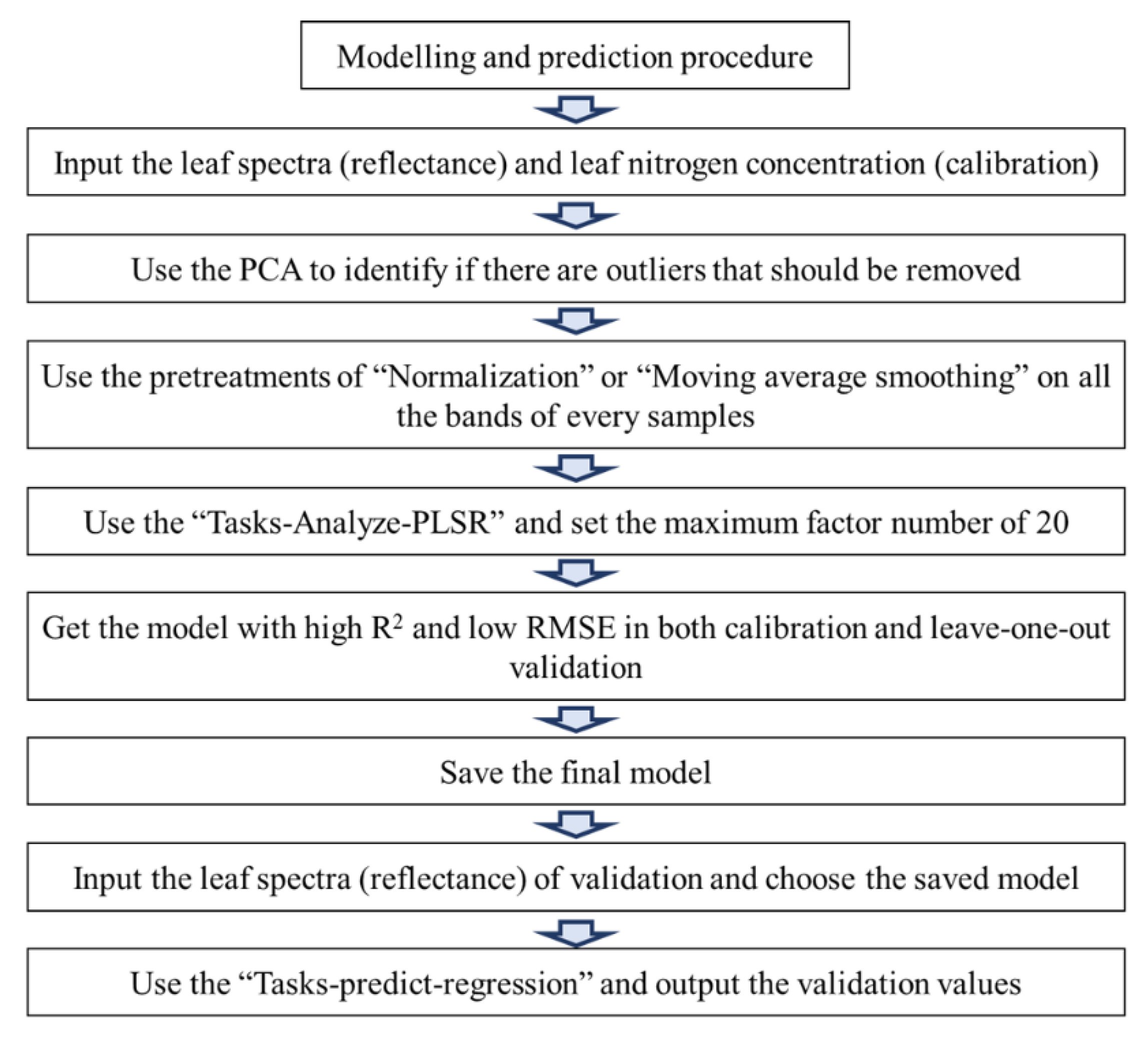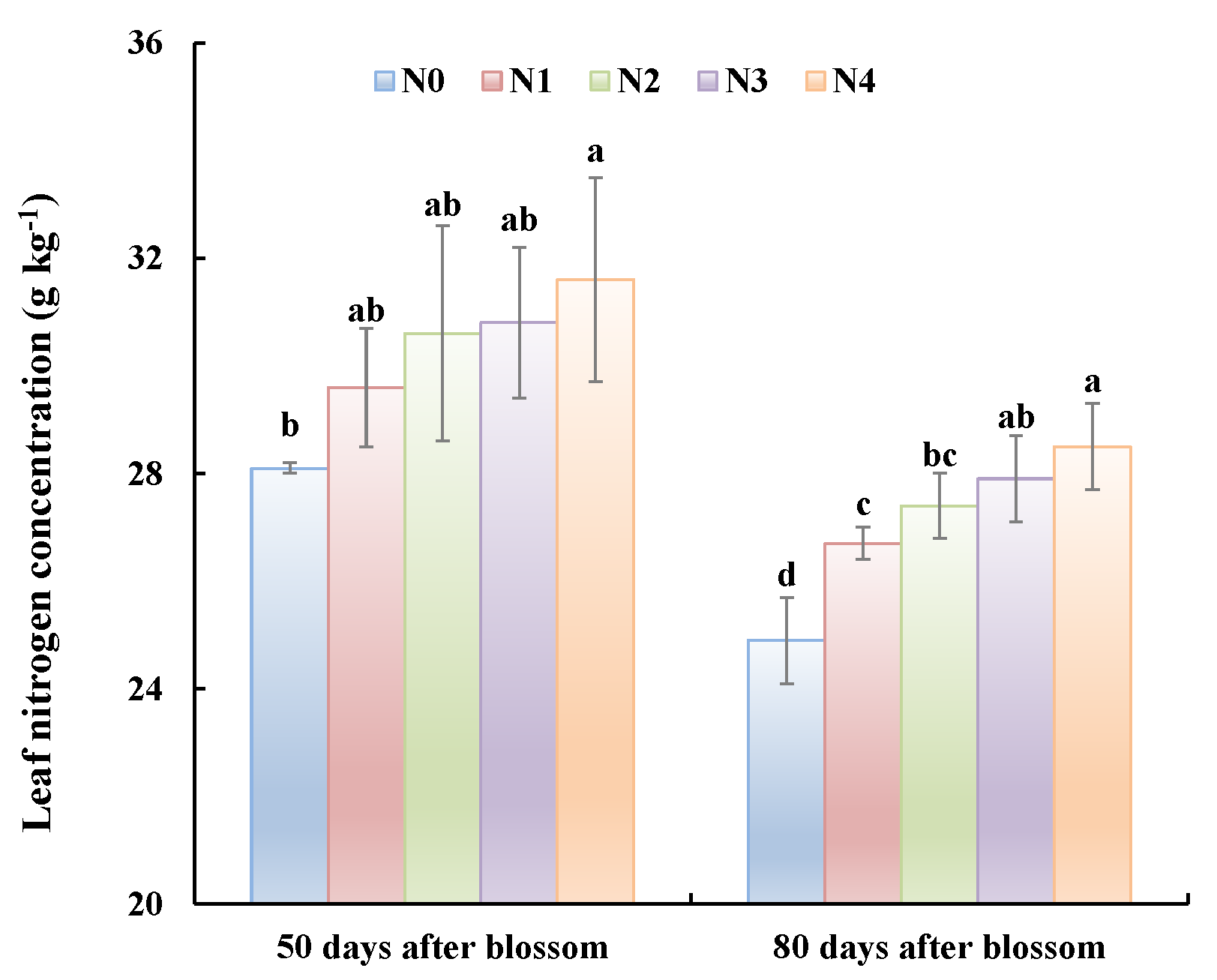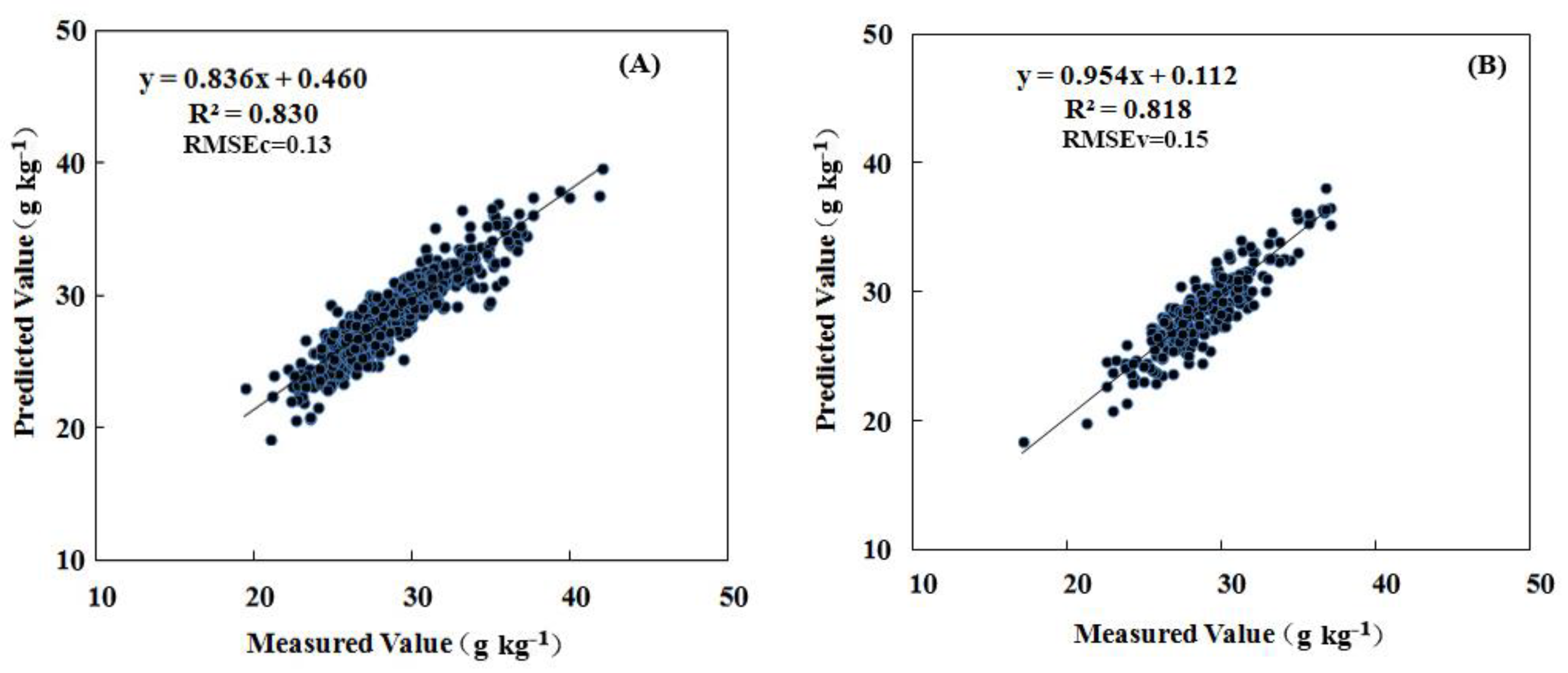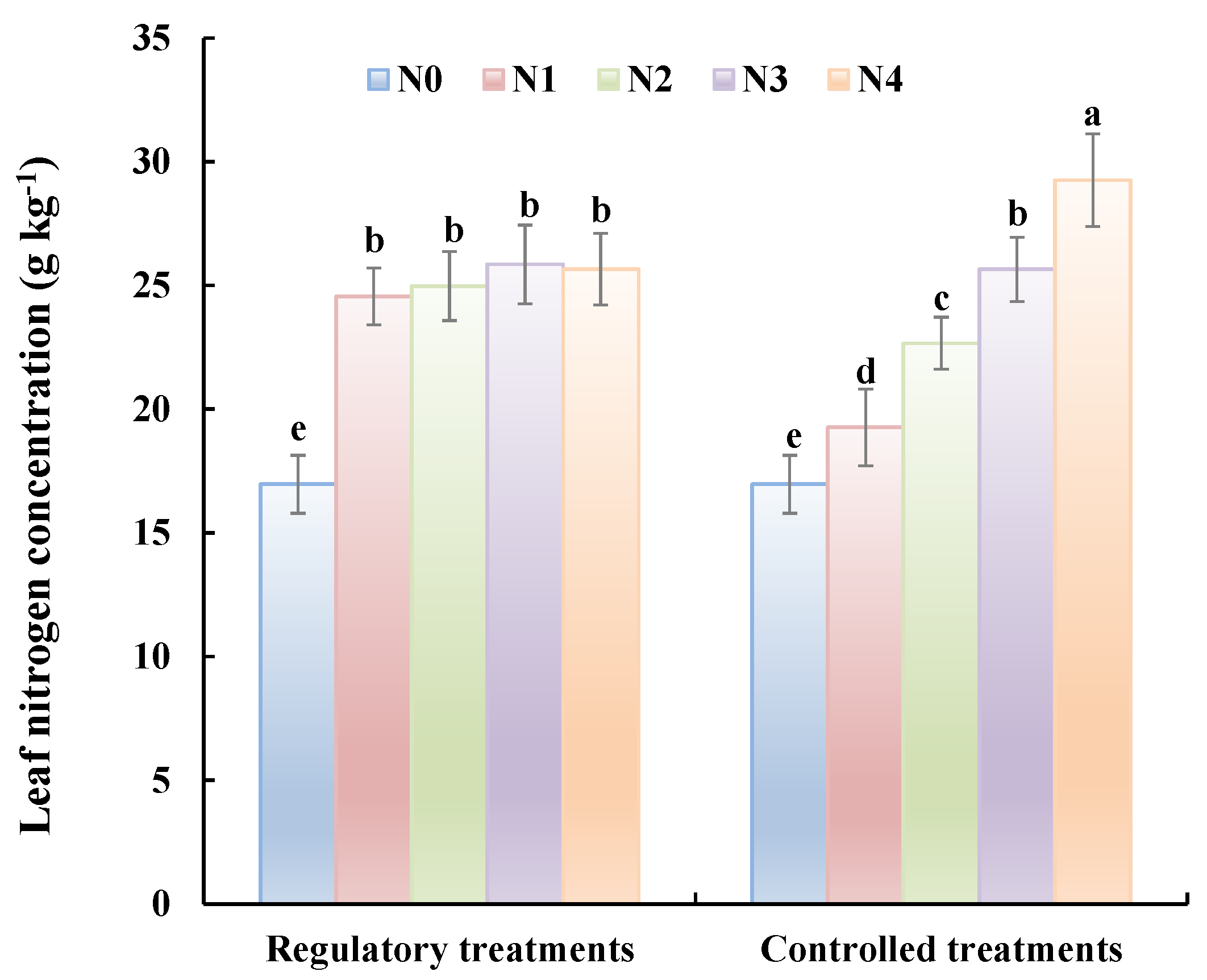Nitrogen Management Based on Visible/Near Infrared Spectroscopy in Pear Orchards
Abstract
:1. Introduction
2. Materials and Methods
2.1. Plant Material
2.2. Leaf Spectra Collection and Leaf Nitrogen Concentration Measurement
2.3. Leaf Nitrogen Concentration Modeling
2.4. Treatments and Topdressing Calculation
2.5. Measurement of Fruit Yield and Quality and PFP-N Calculation
2.6. Statistical Analysis
3. Result
3.1. Leaf N Concentration and Its Diagnosis Model by VIS-SWIR Spectroscopy
3.2. Predicted Leaf Nitrogen Concentration and Calculation of Topdressing
3.3. Leaf Nitrogen Concentration at Maturity
3.4. Effects of Controlled and Regulatory N Application Rates on Fruit Weight and Yield
3.5. Effects of Controlled and Regulatory N Application Rates on Fruit Quality
4. Discussion
5. Conclusions
Supplementary Materials
Author Contributions
Funding
Acknowledgments
Conflicts of Interest
References
- Yang, Y.; Yao, G.; Yue, W.; Zhang, S.; Wu, J. Transcriptome profiling reveals differential gene expression in proanthocyanidin biosynthesis associated with red/green skin color mutant of pear (Pyrus communis L.). Front. Plant Sci. 2015, 6, 795. [Google Scholar] [CrossRef] [Green Version]
- Song, Y.; Fan, L.; Chen, H.; Zhang, M.; Ma, Q.; Zhang, S.; Wu, J. Identifying genetic diversity and a preliminary core collection of Pyrus pyrifolia cultivars by a genome-wide set of SSR markers. Sci. Hortic. 2014, 167, 5–16. [Google Scholar] [CrossRef]
- Quartieri, M.; Millard, P.; Tagliavini, M. Storage and remobilization of nitrogen by pear (Pyruscommunis L.) trees as affected by timing of N supply. Eur. J. Agron. 2002, 17, 105–110. [Google Scholar] [CrossRef]
- Zhang, Y.; Lei, H.; Zhao, W.; Shen, Y.; Xiao, D. Comparison of the water budget for the typical cropland and pear orchard ecosystems in the North China Plain. Agric. Water Manag. 2018, 198, 53–64. [Google Scholar] [CrossRef]
- Lu, S.; Yan, Z.; Chen, Q.; Zhang, F. Evaluation of conventional nitrogen and phosphorus fertilization and potential environmental risk in intensive orchards of north China. J. Plant Nutr. 2012, 35, 1509–1525. [Google Scholar] [CrossRef]
- Duarte, L.; Jordão, P.; Calouro, F.; Sousa, R. Management of nitrogen and potassium fertilizer inputs on fertigated pear orchards and its influence on yield and fruit quality. Acta Hortic. 2010, 868, 307–312. [Google Scholar] [CrossRef]
- Sugar, D.; Righetti, T.L.; Sanchez, E.E.; Khemira, H. Management of Nitrogen and Calcium in Pear Trees for Enhancement of Fruit Resistance to Postharvest Decay. HortTechnology 1992, 2, 382–387. [Google Scholar] [CrossRef] [Green Version]
- Kou, X.; Wu, M.; Li, L.; Wang, S.; Xue, Z.; Liu, B.; Fei, Y. Effects of CaCl2 dipping and pullulan coating on the development of brown spot on ‘Huangguan’ pears during cold storage. Postharvest Biol. Technol. 2015, 99, 63–72. [Google Scholar] [CrossRef]
- Rubio-Covarrubias, O.A.; Brown, P.H.; Weinbaum, S.A.; Johnson, R.S.; Cabrera, R.I. Evaluating foliar nitrogen compounds as indicators of nitrogen status in Prunus persica trees. Sci. Hortic. 2009, 120, 27–33. [Google Scholar] [CrossRef]
- Wang, X.; Feng, A.; Wang, Q.; Wu, C.; Liu, Z.; Ma, Z.; Wei, X. Spatial variability of the nutrient balance and related NPSP risk analysis for agro-ecosystems in China in 2010. Agric. Ecosyst. Environ. 2014, 193, 42–52. [Google Scholar] [CrossRef]
- Hamdi, E.; Javier, A.; Anunciacion, A. Assessment of nutrient removal in bearing peach trees (prunus persical. batsch) based on whole tree analysis. Plant Soil 2013, 369, 421–437. [Google Scholar]
- Zhang, Y.; Shen, Y.; Xu, X.; Sun, H.; Li, F.; Wang, Q. Characteristics of the water–energy–carbon fluxes of irrigated pear (Pyrus bretschneideri Rehd) orchards in the North China Plain. Agric. Water Manag. 2013, 128, 140–148. [Google Scholar] [CrossRef]
- Duan, Y.-H.; Shi, X.-J.; Li, S.-L.; Sun, X.-F.; He, X.-H. Nitrogen Use Efficiency as Affected by Phosphorus and Potassium in Long-Term Rice and Wheat Experiments. J. Integr. Agric. 2014, 13, 588–596. [Google Scholar] [CrossRef]
- Neto, C.B.; Carranca, C.; Clemente, J.; De Varennes, A. Assessing the nitrogen nutritional status of young non-bearing ‘rocha’ pear trees grown in a mediterranean region by using a chlorophyll meter. J. Plant Nutr. 2011, 34, 627–639. [Google Scholar] [CrossRef]
- Wang, W.; Yao, X.; Yao, X.F.; Tian, Y.C.; Liu, X.J.; Ni, J.; Cao, W.X.; Zhu, Y. Estimating leaf nitrogen content with three-band vegetation indices in rice and wheat. Field Crops Res. 2012, 129, 90–98. [Google Scholar] [CrossRef]
- Gerber, F.; Marion, R.; Olioso, A.; Jacquemoud, S.; Da Luz, B.R.; Fabre, S. Modeling directional–hemispherical reflectance and transmittance of fresh and dry leaves from 0.4 μm to 5.7 μm with the PROSPECT-VISIR model. Remote Sens. Environ. 2011, 115, 404–414. [Google Scholar] [CrossRef]
- Verrelst, J.; Camps-Valls, G.; Muñoz-Marí, J.; Rivera, J.; Veroustraete, F.; Clevers, J.; Moreno, J. Optical remote sensing and the retrieval of terrestrial vegetation bio-geophysical properties—A review. ISPRS J. Photogramm. Remote Sens. 2015, 108, 273–290. [Google Scholar] [CrossRef]
- Berger, K.; Verrelst, J.; Féret, J.-B.; Wang, Z.; Wocher, M.; Strathmann, M.; Danner, M.; Mauser, W.; Hank, T. Crop nitrogen monitoring: Recent progress and principal developments in the context of imaging spectroscopy missions. Remote Sens. Environ. 2020, 242, 111758. [Google Scholar] [CrossRef]
- Wang, Z.; Skidmore, A.K.; Darvishzadeh, R.; Heiden, U.; Heurich, M.; Wang, T. Leaf Nitrogen Content Indirectly Estimated by Leaf Traits Derived From the PROSPECT Model. IEEE J. Sel. Top. Appl. Earth Obs. Remote Sens. 2015, 8, 3172–3182. [Google Scholar] [CrossRef]
- Curran, P.J. Remote sensing of foliar chemistry. Remote Sens. Environ. 1989, 30, 271–278. [Google Scholar] [CrossRef]
- Kokaly, R.F.; Clark, R.N. Spectroscopic determination of leaf biochemistry using band-depth analysis of absorption features and stepwise multiple linear regression. Remote Sens. Environ. 1999, 67, 267–287. [Google Scholar] [CrossRef]
- Kokaly, R.F.; Asner, G.P.; Ollinger, S.V.; Martin, M.E.; Wessman, C.A. Characterizing canopy biochemistry from imaging spectroscopy and its application to ecosystem studies. Remote Sens. Environ. 2009, 113, S78–S91. [Google Scholar] [CrossRef]
- Berger, K.; Verrelst, J.; Féret, J.-B.; Hank, T.; Wocher, M.; Mauser, W.; Camps-Valls, G. Retrieval of aboveground crop nitrogen content with a hybrid machine learning method. Int. J. Appl. Earth Obs. Geoinf. 2020, 92, 102174. [Google Scholar] [CrossRef]
- Féret, J.-B.; Berger, K.; de Boissieu, F.; Malenovský, Z. PROSPECT-PRO for estimating content of nitrogen-containing leaf proteins and other carbon-based constituents. Remote Sens. Environ. 2021, 252, 112173. [Google Scholar] [CrossRef]
- Wang, J.; Shen, C.; Liu, N.; Jin, X.; Fan, X.; Dong, C.; Xu, Y. Non-Destructive Evaluation of the Leaf Nitrogen Concentration by In-Field Visible/Near-Infrared Spectroscopy in Pear Orchards. Sensors 2017, 17, 538. [Google Scholar] [CrossRef] [PubMed] [Green Version]
- Wang, J.; Zhao, H.; Shen, C.; Chen, Q.; Dong, C.; Xu, Y. Determination of Nitrogen Concentration in Fresh Pear Leaves by Visible/Near-Infrared Reflectance Spectroscopy. Agron. J. 2014, 106, 1867–1872. [Google Scholar]
- Ata-Ul-Karim, S.T.; Liu, X.; Lu, Z.; Zheng, H.; Cao, W.; Zhu, Y. Estimation of nitrogen fertilizer requirement for rice crop using critical nitrogen dilution curve. Field Crop. Res. 2017, 201, 32–40. [Google Scholar] [CrossRef]
- Hanlon, E.A.; Morgan, K.T.; Obreza, T.A.; Mylavarapu, R.S. Leaf Analysis in Citrus: Developments in Analytical Techniques. Adv. Citrus Nutr. 2012, 6, 81–87. [Google Scholar] [CrossRef]
- Suarez, L.; Berni, J.A.J. Spectral Response of Citrus and Their Application to Nutrient and Water Constraints Diagnosis. Adv. Citrus Nutr. 2012, 10, 125–141. [Google Scholar] [CrossRef]
- Chen, L.; Wu, T.; Zhang, S.L.; Yao, G.F.; Tao, S.T.; Jia, B.; Cao, H. Effects of nitrogen fertilizer on fruit quality and leaf physiological metabolism of Hosui pear. J. Fruit Sci. 2010, 27, 871–876. [Google Scholar]
- Carranca, C.; Brunetto, G.; Tagliavini, M. Nitrogen Nutrition of Fruit Trees to Reconcile Productivity and Environmental Concerns. Plants 2018, 7, 4. [Google Scholar] [CrossRef] [Green Version]
- Lukina, E.V.; Freeman, K.W.; Wynn, K.J.; Thomason, W.E.; Mullen, R.W.; Stone, M.L.; Solie, J.B.; Klatt, A.R.; Johnson, G.V.; Elliott, R.L.; et al. Nitrogen fertilization optimization algorithm based on in-season estimates of yield and plant nitrogen uptake. J. Plant Nutr. 2001, 24, 885–898. [Google Scholar] [CrossRef]
- Mulla, D.J. Twenty five years of remote sensing in precision agriculture: Key advances and remaining knowledge gaps. Biosyst. Eng. 2013, 114, 358–371. [Google Scholar] [CrossRef]
- Kitchen, N.R.; Sudduth, K.A.; Drummond, S.T.; Scharf, P.C.; Palm, H.L.; Roberts, D.F.; Vories, E.D. Ground-Based Canopy Reflectance Sensing for Variable-Rate Nitrogen Corn Fertilization. Agron. J. 2010, 102, 71–84. [Google Scholar] [CrossRef] [Green Version]
- Oliveira, L.F.; Scharf, P.C.; Vories, E.D.; Drummond, S.T.; Dunn, D.; Stevens, W.G.; Bronson, K.F.; Benson, N.R.; Hubbard, V.C.; Jones, A.S. Calibrating Canopy Reflectance Sensors to Predict Optimal Mid-Season Nitrogen Rate for Cotton. Soil Sci. Soc. Am. J. 2012, 77, 173–183. [Google Scholar] [CrossRef]
- Tagliavini, M.; Quartieri, M.; Millard, P. Remobilized nitrogen and root uptake of nitrate for spring leaf growth, flowers and developing fruits of pear (Pyrus communis L.) trees. Plant Soil 1997, 195, 137–142. [Google Scholar] [CrossRef]
- Saeys, W.; Mouazen, A.; Ramon, H. Potential for Onsite and Online Analysis of Pig Manure using Visible and Near Infrared Reflectance Spectroscopy. Biosyst. Eng. 2005, 91, 393–402. [Google Scholar] [CrossRef]
- Gómez, A.H.; He, Y.; Pereira, A.G. Non-destructive measurement of acidity, soluble solids and firmness of Satsuma mandarin using Vis/NIR-spectroscopy techniques. J. Food Eng. 2006, 77, 313–319. [Google Scholar] [CrossRef]
- Yin, C.-Y.; Zhang, H.-C.; Zhang, Q.; Wei, H.-Y.; Dai, Q.-G.; Huo, Z.-Y.; Xu, K.; Ma, Q.; Li, M.; Li, G.-Y. Preliminary Study on Parameters of Precise and Quantitative Nitrogen Appli-cation in Rice Varieties with Different Growth Period Durations. Acta Agron. Sin. 2010, 36, 1342–1354. [Google Scholar] [CrossRef]
- Buwalda, J.; Meekings, J. Seasonal accumulation of mineral nutrients in leaves and fruit of Japanese pear (Pyrus serotina Rehd.). Sci. Hortic. 1990, 41, 209–222. [Google Scholar] [CrossRef]
- Hou, C.; Zhang, S.; Jin, C.; Wu, J. Changing of Mineral Nutrition Distribution in “Cuguan Pear” Tree. Chin. Agric. Sci. Bull. 2012, 28, 173–178. (In Chinese) [Google Scholar]
- Park, D.S.; Tilahun, S.; Heo, J.Y.; Jeong, C.S. Quality and expression of ethylene response genes of ‘Daebong’ persimmon fruit during ripening at different temperatures. Postharvest Biol. Technol. 2017, 133, 57–63. [Google Scholar] [CrossRef]
- Wang, J.; Zhang, L.; He, X.; Zhang, Y.; Wan, Y.; Duan, S.; Xu, C.; Mao, X.; Chen, X.; Shi, X. Environmental mitigation potential by improved nutrient managements in pear (Pyrus pyrifolia L.) orchards based on life cycle assessment: A case study in the North China Plain. J. Clean. Prod. 2020, 262, 121273. [Google Scholar] [CrossRef]
- Verrelst, J.; Berger, K.; Rivera-Caicedo, J.P. Intelligent Sampling for Vegetation Nitrogen Mapping Based on Hybrid Machine Learning Algorithms. IEEE Geosci. Remote Sens. Lett. 2020, 99, 1–5. [Google Scholar] [CrossRef]
- Verrelst, J.; Malenovský, Z.; Van Der Tol, C.; Camps-Valls, G.; Gastellu-Etchegorry, J.-P.; Lewis, P.; North, P.; Moreno, J. Quantifying Vegetation Biophysical Variables from Imaging Spectroscopy Data: A Review on Retrieval Methods. Surv. Geophys. 2019, 40, 589–629. [Google Scholar] [CrossRef] [Green Version]
- Cheng, L.; Ma, F.; Ranwala, D. Nitrogen storage and its interaction with carbohydrates of young apple trees in response to nitrogen supply. Tree Physiol. 2004, 24, 91–98. [Google Scholar] [CrossRef] [Green Version]
- Zegbe, J.A.; Serna-Pérez, A.; Mena-Covarrubias, J. Mineral nutrition enhances yield and affects fruit quality of ‘cristalina’ cactus pear. Sci. Hortic. 2014, 167, 63–70. [Google Scholar] [CrossRef]





| Treatment | Total N Rate | Total Urea | Base Urea Rate (60%) | Topdressing Urea (40%) |
|---|---|---|---|---|
| N0 | 0 | 0 | 0 | 0 |
| N1 | 100 | 218 | 131 | 87 |
| Nr1 | 131 + X1 | 131 | X1 | |
| N2 | 200 | 435 | 261 | 174 |
| Nr2 | 261 + X2 | 261 | X2 | |
| N3 | 300 | 518 | 311 | 207 |
| Nr3 | 311 + X3 | 311 | X3 | |
| N4 | 400 | 870 | 522 | 348 |
| Nr4 | 522 + X4 | 522 | X4 |
| Data Sets | Sample Number | Min. | Max. | Average |
|---|---|---|---|---|
| g·kg−1 | ||||
| All | 1010 | 18.38 | 42.41 | 29.31 ± 3.82 |
| Calibration | 780 | 20.96 | 42.41 | 29.67 ± 3.96 |
| Validation | 230 | 18.38 | 37.73 | 28.09 ± 3.00 |
| Modeling Scenarios | Factor Number | Calibration | Leave-One-Out Validation | ||
|---|---|---|---|---|---|
| R2 | RMSE | R2 | RMSE | ||
| 350–1300 nm | 11 | 0.66 | 0.22 | 0.64 | 0.23 |
| 1300–2500 nm | 14 | 0.76 | 0.19 | 0.75 | 0.19 |
| All bands | 14 | 0.81 | 0.16 | 0.80 | 0.17 |
| All bands with Normalization | 14 | 0.83 | 0.13 | 0.82 | 0.15 |
| All bands with MAS | 14 | 0.82 | 0.16 | 0.80 | 0.17 |
| Treatments | Fruit Number | Branch Number | |
|---|---|---|---|
| Controlled treatments | N0 | 9.2 ± 2.6 c | 13.2 ± 3.1 b |
| N1 | 10.3 ± 3.0 b | 16.3 ± 3.5 ab | |
| N2 | 10.7 ± 2.5 b | 15.1 ± 3.1 ab | |
| N3 | 13.3 ± 3.7 a | 16.2 ± 3.4 ab | |
| N4 | 12.5 ± 3.5 a | 17.6 ± 2.1 ab | |
| Regulatory treatments | Nr1 | 12.3 ± 3.2 a | 17.8 ± 2.0 ab |
| Nr2 | 11.8 ± 3.7 ab | 14.8 ± 2.8 b | |
| Nr3 | 11.7 ± 2.9 ab | 18.0 ± 1.7 a | |
| Nr4 | 10.8 ± 2.9 b | 14.8 ± 2.8 b |
| Treatment | Total N Rate | Total Urea | Base Urea | Topdressing Urea | Real Total Urea |
|---|---|---|---|---|---|
| g·plant−1 | |||||
| N0 | 0 | 0 | 0 | 0 | 0 |
| Nr1 | 317 | 131 + X1 | 131 | X1 | 689 |
| Nr2 | 308 | 261 + X2 | 261 | X2 | 670 |
| Nr3 | 291 | 311 + X3 | 311 | X3 | 633 |
| Nr4 | 300 | 522 + X4 | 522 | X4 | 652 |
| Treatments | Single Fruit Weight (g) | Yield (kg per tree) | PFP-N (kg·kg−1) |
|---|---|---|---|
| N0 | 160.64 ± 11.87 d | 1.45 ± 0.11 d | — |
| N1 | 211.24 ± 12.16 c | 2.20 ± 0.17 c | 22 |
| N2 | 228.09 ± 7.76 b | 2.28 ± 0.08 c | 11.4 |
| N3 | 232.60 ± 4.50 b | 3.02 ± 0.06 ab | 10.1 |
| N4 | 257.07 ± 12.79 a | 3.08 ± 0.15 a | 7.7 |
| Nr1 | 231.24 ± 7.82 b | 2.77 ± 0.09 b | 8.7 |
| Nr2 | 233.25 ± 11.75 bc | 2.80 ± 0.14 b | 9.1 |
| Nr3 | 237.67 ± 12.45 ab | 2.78 ± 0.28 b | 9.5 |
| Nr4 | 238.60 ± 9.91 ab | 2.62 ± 0.11 b | 8.7 |
| Treatments | Firmness (N) | TSS (%) | TD (cm) | VD (cm) |
|---|---|---|---|---|
| N0 | 21.81 ± 2.10 a | 10.23 ± 0.06 d | 6.68 ± 0.37 d | 6.08 ± 0.21 d |
| N1 | 21.67 ± 0.67 a | 10.87 ± 0.17 bc | 7.45 ± 0.06 c | 6.94 ± 0.11 c |
| N2 | 21.32 ± 1.96 a | 11.99 ± 0.14 a | 7.76 ± 0.06 ab | 7.11 ± 0.18 c |
| N3 | 20.96 ± 0.62 a | 12.32 ± 0.31 a | 7.87 ± 0.14 ab | 7.34 ± 0.16 ab |
| N4 | 20.34 ± 0.89 a | 11.42 ± 0.13 b | 8.17 ± 0.03 a | 7.32 ± 0.04 ab |
| Nr1 | 19.90 ± 0.34 a | 10.98 ± 0.25 c | 7.84 ± 0.15 ab | 7.23 ± 0.28 bc |
| Nr2 | 21.09 ± 0.36 a | 11.42 ± 0.57 b | 7.87 ± 0.21 ab | 7.21 ± 0.24 bc |
| Nr3 | 21.63 ± 0.40 a | 11.03 ± 0.33 bc | 8.05 ± 0.10 ab | 7.61 ± 0.08 a |
| Nr4 | 21.56 ± 0.36 a | 11.31 ± 0.28 bc | 7.79 ± 0.15 ab | 7.27 ± 0.15 bc |
Publisher’s Note: MDPI stays neutral with regard to jurisdictional claims in published maps and institutional affiliations. |
© 2021 by the authors. Licensee MDPI, Basel, Switzerland. This article is an open access article distributed under the terms and conditions of the Creative Commons Attribution (CC BY) license (http://creativecommons.org/licenses/by/4.0/).
Share and Cite
Wang, J.; Shi, X.; Xu, Y.; Dong, C. Nitrogen Management Based on Visible/Near Infrared Spectroscopy in Pear Orchards. Remote Sens. 2021, 13, 927. https://doi.org/10.3390/rs13050927
Wang J, Shi X, Xu Y, Dong C. Nitrogen Management Based on Visible/Near Infrared Spectroscopy in Pear Orchards. Remote Sensing. 2021; 13(5):927. https://doi.org/10.3390/rs13050927
Chicago/Turabian StyleWang, Jie, Xiaojun Shi, Yangchun Xu, and Caixia Dong. 2021. "Nitrogen Management Based on Visible/Near Infrared Spectroscopy in Pear Orchards" Remote Sensing 13, no. 5: 927. https://doi.org/10.3390/rs13050927
APA StyleWang, J., Shi, X., Xu, Y., & Dong, C. (2021). Nitrogen Management Based on Visible/Near Infrared Spectroscopy in Pear Orchards. Remote Sensing, 13(5), 927. https://doi.org/10.3390/rs13050927







